Report: Comparing Procurement Methods for Construction Projects
VerifiedAdded on 2022/10/15
|12
|2230
|15
Report
AI Summary
This report provides a comprehensive analysis of three distinct procurement methods used in construction projects: Request for Quotations, Two-Stage Tendering, and Open Tendering. It begins with an executive summary and introduction, followed by detailed examinations of each method, outlining their advantages and disadvantages. The report assesses the benefits and problems associated with each method for various stakeholders, including clients/developers, consultants, builders, subcontractors, and end-users. A comparison section highlights the key differences between the three methods, and recommendations are offered to guide project owners/developers in selecting the most appropriate procurement strategy based on project characteristics and ethical considerations. The report concludes with a disclaimer and a list of cited references, adhering to the WSU Harvard referencing system.
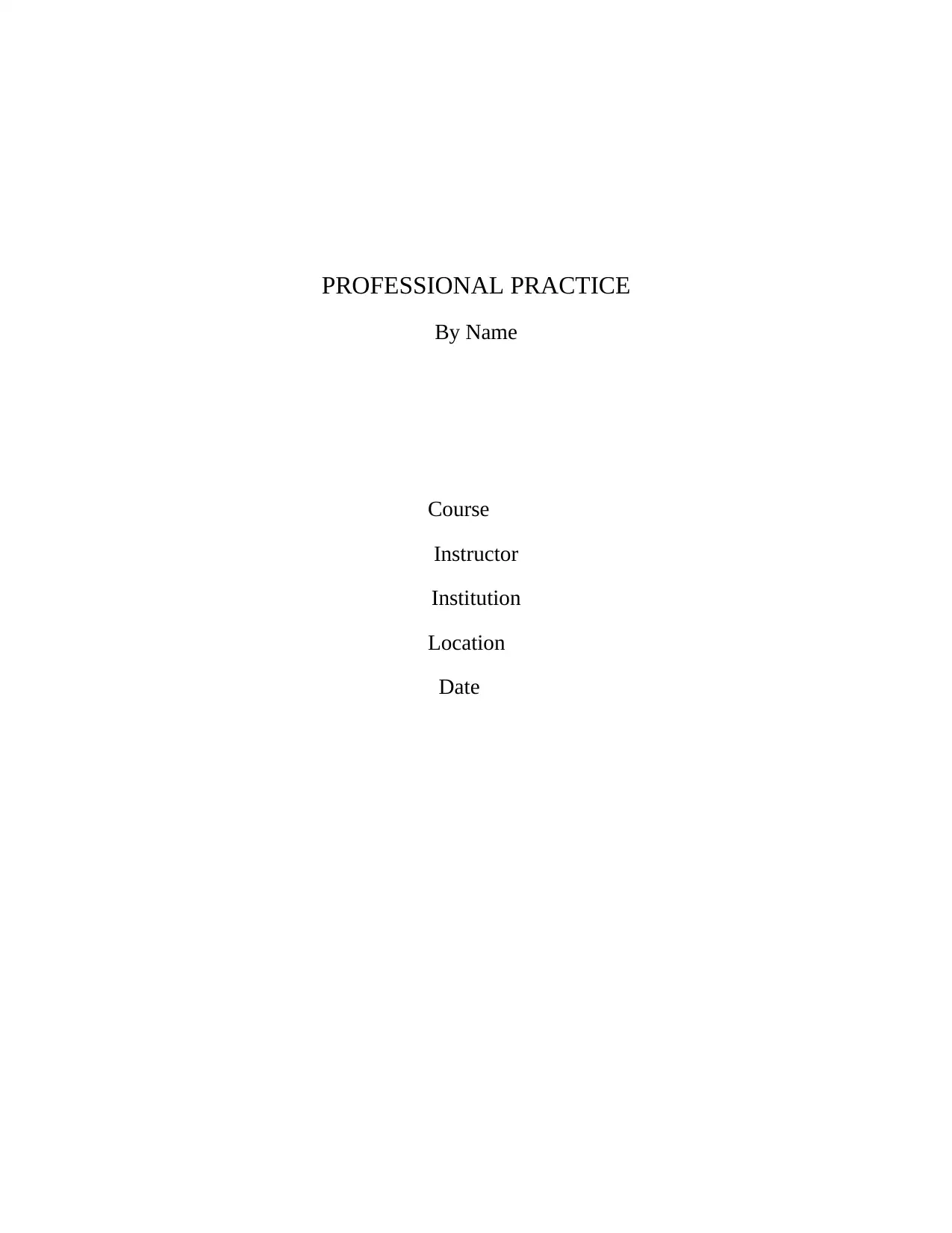
PROFESSIONAL PRACTICE
By Name
Course
Instructor
Institution
Location
Date
By Name
Course
Instructor
Institution
Location
Date
Paraphrase This Document
Need a fresh take? Get an instant paraphrase of this document with our AI Paraphraser
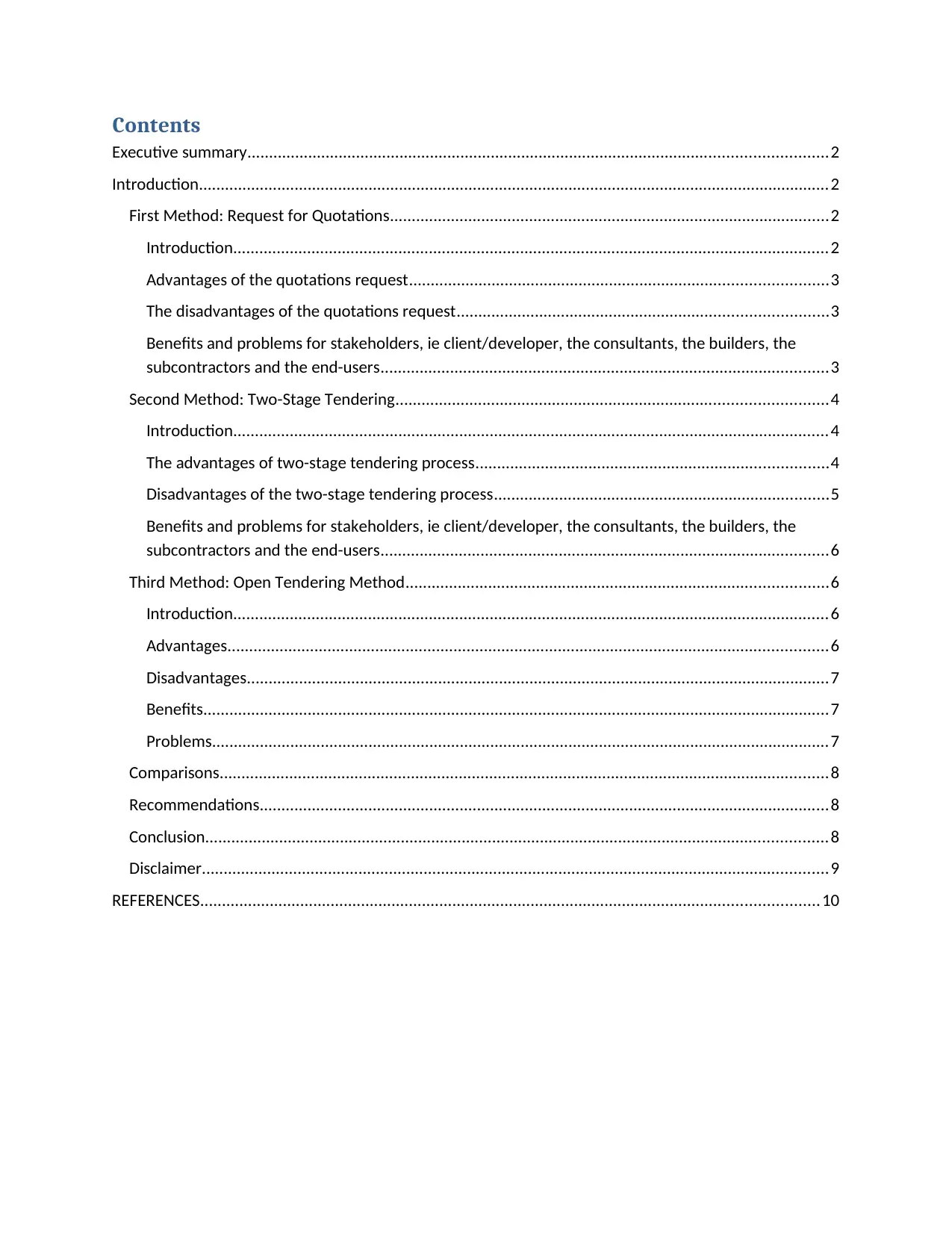
Contents
Executive summary.....................................................................................................................................2
Introduction.................................................................................................................................................2
First Method: Request for Quotations.....................................................................................................2
Introduction.........................................................................................................................................2
Advantages of the quotations request................................................................................................3
The disadvantages of the quotations request.....................................................................................3
Benefits and problems for stakeholders, ie client/developer, the consultants, the builders, the
subcontractors and the end-users.......................................................................................................3
Second Method: Two-Stage Tendering...................................................................................................4
Introduction.........................................................................................................................................4
The advantages of two-stage tendering process.................................................................................4
Disadvantages of the two-stage tendering process.............................................................................5
Benefits and problems for stakeholders, ie client/developer, the consultants, the builders, the
subcontractors and the end-users.......................................................................................................6
Third Method: Open Tendering Method.................................................................................................6
Introduction.........................................................................................................................................6
Advantages..........................................................................................................................................6
Disadvantages......................................................................................................................................7
Benefits................................................................................................................................................7
Problems..............................................................................................................................................7
Comparisons............................................................................................................................................8
Recommendations...................................................................................................................................8
Conclusion...............................................................................................................................................8
Disclaimer................................................................................................................................................9
REFERENCES..............................................................................................................................................10
Executive summary.....................................................................................................................................2
Introduction.................................................................................................................................................2
First Method: Request for Quotations.....................................................................................................2
Introduction.........................................................................................................................................2
Advantages of the quotations request................................................................................................3
The disadvantages of the quotations request.....................................................................................3
Benefits and problems for stakeholders, ie client/developer, the consultants, the builders, the
subcontractors and the end-users.......................................................................................................3
Second Method: Two-Stage Tendering...................................................................................................4
Introduction.........................................................................................................................................4
The advantages of two-stage tendering process.................................................................................4
Disadvantages of the two-stage tendering process.............................................................................5
Benefits and problems for stakeholders, ie client/developer, the consultants, the builders, the
subcontractors and the end-users.......................................................................................................6
Third Method: Open Tendering Method.................................................................................................6
Introduction.........................................................................................................................................6
Advantages..........................................................................................................................................6
Disadvantages......................................................................................................................................7
Benefits................................................................................................................................................7
Problems..............................................................................................................................................7
Comparisons............................................................................................................................................8
Recommendations...................................................................................................................................8
Conclusion...............................................................................................................................................8
Disclaimer................................................................................................................................................9
REFERENCES..............................................................................................................................................10
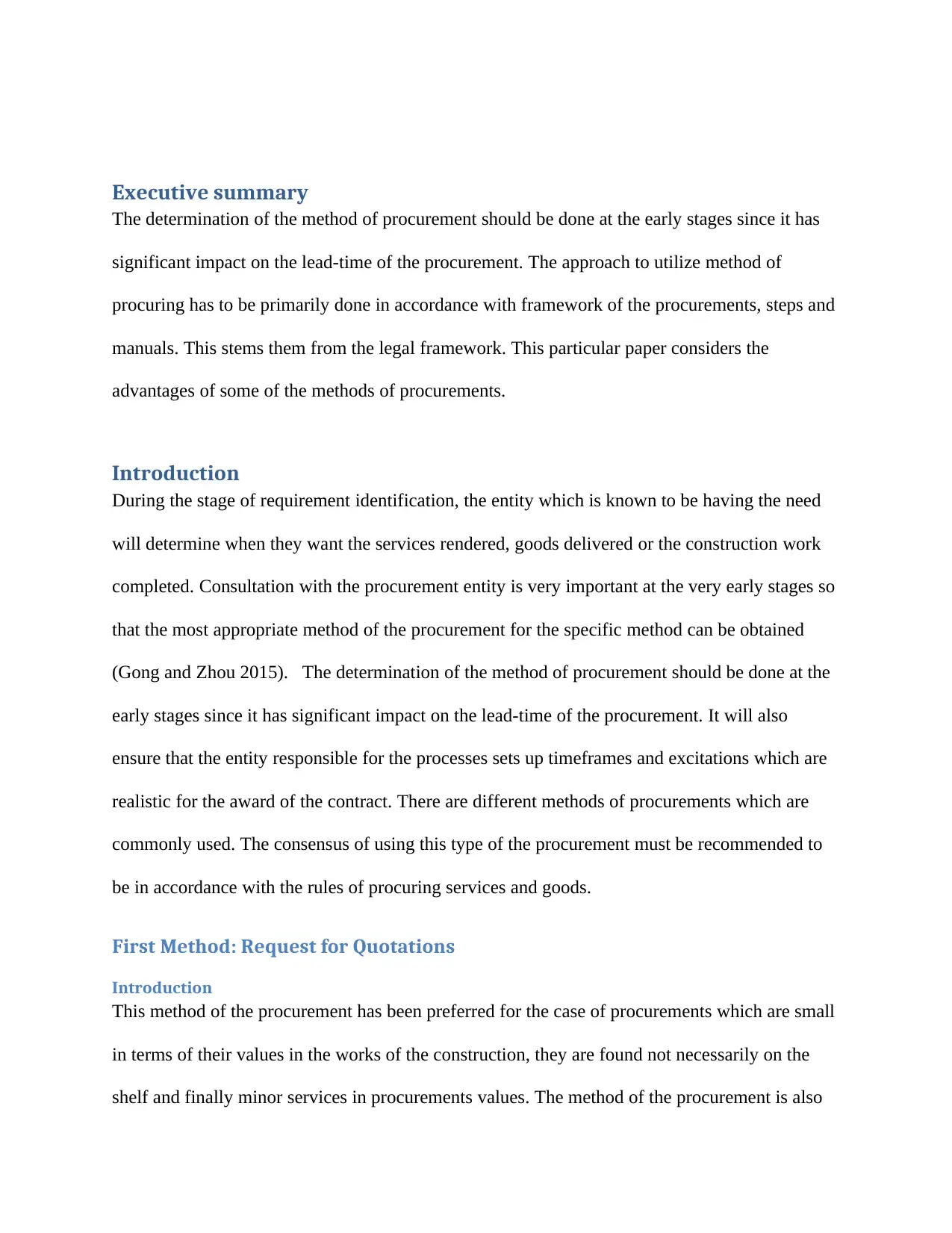
Executive summary
The determination of the method of procurement should be done at the early stages since it has
significant impact on the lead-time of the procurement. The approach to utilize method of
procuring has to be primarily done in accordance with framework of the procurements, steps and
manuals. This stems them from the legal framework. This particular paper considers the
advantages of some of the methods of procurements.
Introduction
During the stage of requirement identification, the entity which is known to be having the need
will determine when they want the services rendered, goods delivered or the construction work
completed. Consultation with the procurement entity is very important at the very early stages so
that the most appropriate method of the procurement for the specific method can be obtained
(Gong and Zhou 2015). The determination of the method of procurement should be done at the
early stages since it has significant impact on the lead-time of the procurement. It will also
ensure that the entity responsible for the processes sets up timeframes and excitations which are
realistic for the award of the contract. There are different methods of procurements which are
commonly used. The consensus of using this type of the procurement must be recommended to
be in accordance with the rules of procuring services and goods.
First Method: Request for Quotations
Introduction
This method of the procurement has been preferred for the case of procurements which are small
in terms of their values in the works of the construction, they are found not necessarily on the
shelf and finally minor services in procurements values. The method of the procurement is also
The determination of the method of procurement should be done at the early stages since it has
significant impact on the lead-time of the procurement. The approach to utilize method of
procuring has to be primarily done in accordance with framework of the procurements, steps and
manuals. This stems them from the legal framework. This particular paper considers the
advantages of some of the methods of procurements.
Introduction
During the stage of requirement identification, the entity which is known to be having the need
will determine when they want the services rendered, goods delivered or the construction work
completed. Consultation with the procurement entity is very important at the very early stages so
that the most appropriate method of the procurement for the specific method can be obtained
(Gong and Zhou 2015). The determination of the method of procurement should be done at the
early stages since it has significant impact on the lead-time of the procurement. It will also
ensure that the entity responsible for the processes sets up timeframes and excitations which are
realistic for the award of the contract. There are different methods of procurements which are
commonly used. The consensus of using this type of the procurement must be recommended to
be in accordance with the rules of procuring services and goods.
First Method: Request for Quotations
Introduction
This method of the procurement has been preferred for the case of procurements which are small
in terms of their values in the works of the construction, they are found not necessarily on the
shelf and finally minor services in procurements values. The method of the procurement is also
⊘ This is a preview!⊘
Do you want full access?
Subscribe today to unlock all pages.

Trusted by 1+ million students worldwide
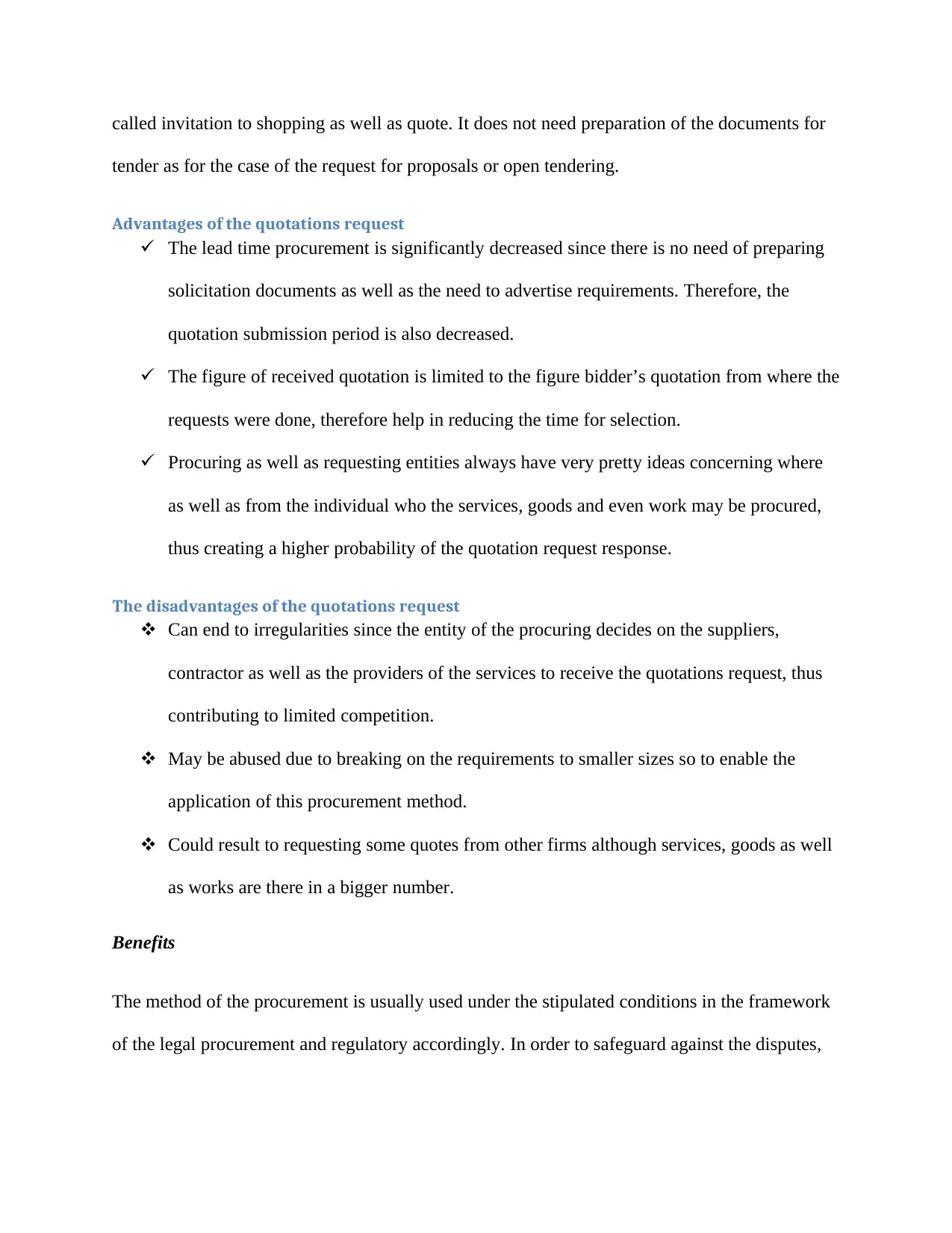
called invitation to shopping as well as quote. It does not need preparation of the documents for
tender as for the case of the request for proposals or open tendering.
Advantages of the quotations request
The lead time procurement is significantly decreased since there is no need of preparing
solicitation documents as well as the need to advertise requirements. Therefore, the
quotation submission period is also decreased.
The figure of received quotation is limited to the figure bidder’s quotation from where the
requests were done, therefore help in reducing the time for selection.
Procuring as well as requesting entities always have very pretty ideas concerning where
as well as from the individual who the services, goods and even work may be procured,
thus creating a higher probability of the quotation request response.
The disadvantages of the quotations request
Can end to irregularities since the entity of the procuring decides on the suppliers,
contractor as well as the providers of the services to receive the quotations request, thus
contributing to limited competition.
May be abused due to breaking on the requirements to smaller sizes so to enable the
application of this procurement method.
Could result to requesting some quotes from other firms although services, goods as well
as works are there in a bigger number.
Benefits
The method of the procurement is usually used under the stipulated conditions in the framework
of the legal procurement and regulatory accordingly. In order to safeguard against the disputes,
tender as for the case of the request for proposals or open tendering.
Advantages of the quotations request
The lead time procurement is significantly decreased since there is no need of preparing
solicitation documents as well as the need to advertise requirements. Therefore, the
quotation submission period is also decreased.
The figure of received quotation is limited to the figure bidder’s quotation from where the
requests were done, therefore help in reducing the time for selection.
Procuring as well as requesting entities always have very pretty ideas concerning where
as well as from the individual who the services, goods and even work may be procured,
thus creating a higher probability of the quotation request response.
The disadvantages of the quotations request
Can end to irregularities since the entity of the procuring decides on the suppliers,
contractor as well as the providers of the services to receive the quotations request, thus
contributing to limited competition.
May be abused due to breaking on the requirements to smaller sizes so to enable the
application of this procurement method.
Could result to requesting some quotes from other firms although services, goods as well
as works are there in a bigger number.
Benefits
The method of the procurement is usually used under the stipulated conditions in the framework
of the legal procurement and regulatory accordingly. In order to safeguard against the disputes,
Paraphrase This Document
Need a fresh take? Get an instant paraphrase of this document with our AI Paraphraser
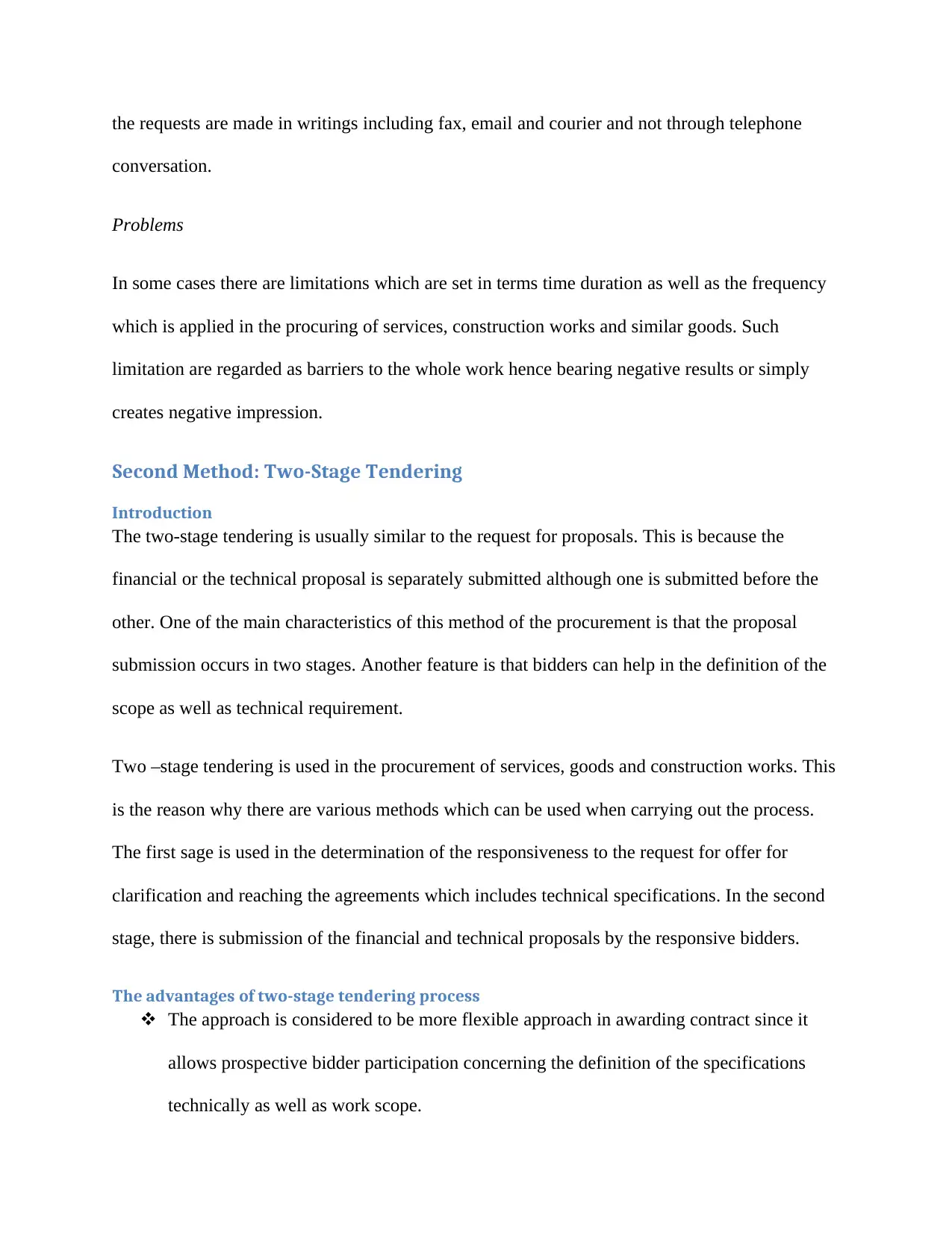
the requests are made in writings including fax, email and courier and not through telephone
conversation.
Problems
In some cases there are limitations which are set in terms time duration as well as the frequency
which is applied in the procuring of services, construction works and similar goods. Such
limitation are regarded as barriers to the whole work hence bearing negative results or simply
creates negative impression.
Second Method: Two-Stage Tendering
Introduction
The two-stage tendering is usually similar to the request for proposals. This is because the
financial or the technical proposal is separately submitted although one is submitted before the
other. One of the main characteristics of this method of the procurement is that the proposal
submission occurs in two stages. Another feature is that bidders can help in the definition of the
scope as well as technical requirement.
Two –stage tendering is used in the procurement of services, goods and construction works. This
is the reason why there are various methods which can be used when carrying out the process.
The first sage is used in the determination of the responsiveness to the request for offer for
clarification and reaching the agreements which includes technical specifications. In the second
stage, there is submission of the financial and technical proposals by the responsive bidders.
The advantages of two-stage tendering process
The approach is considered to be more flexible approach in awarding contract since it
allows prospective bidder participation concerning the definition of the specifications
technically as well as work scope.
conversation.
Problems
In some cases there are limitations which are set in terms time duration as well as the frequency
which is applied in the procuring of services, construction works and similar goods. Such
limitation are regarded as barriers to the whole work hence bearing negative results or simply
creates negative impression.
Second Method: Two-Stage Tendering
Introduction
The two-stage tendering is usually similar to the request for proposals. This is because the
financial or the technical proposal is separately submitted although one is submitted before the
other. One of the main characteristics of this method of the procurement is that the proposal
submission occurs in two stages. Another feature is that bidders can help in the definition of the
scope as well as technical requirement.
Two –stage tendering is used in the procurement of services, goods and construction works. This
is the reason why there are various methods which can be used when carrying out the process.
The first sage is used in the determination of the responsiveness to the request for offer for
clarification and reaching the agreements which includes technical specifications. In the second
stage, there is submission of the financial and technical proposals by the responsive bidders.
The advantages of two-stage tendering process
The approach is considered to be more flexible approach in awarding contract since it
allows prospective bidder participation concerning the definition of the specifications
technically as well as work scope.
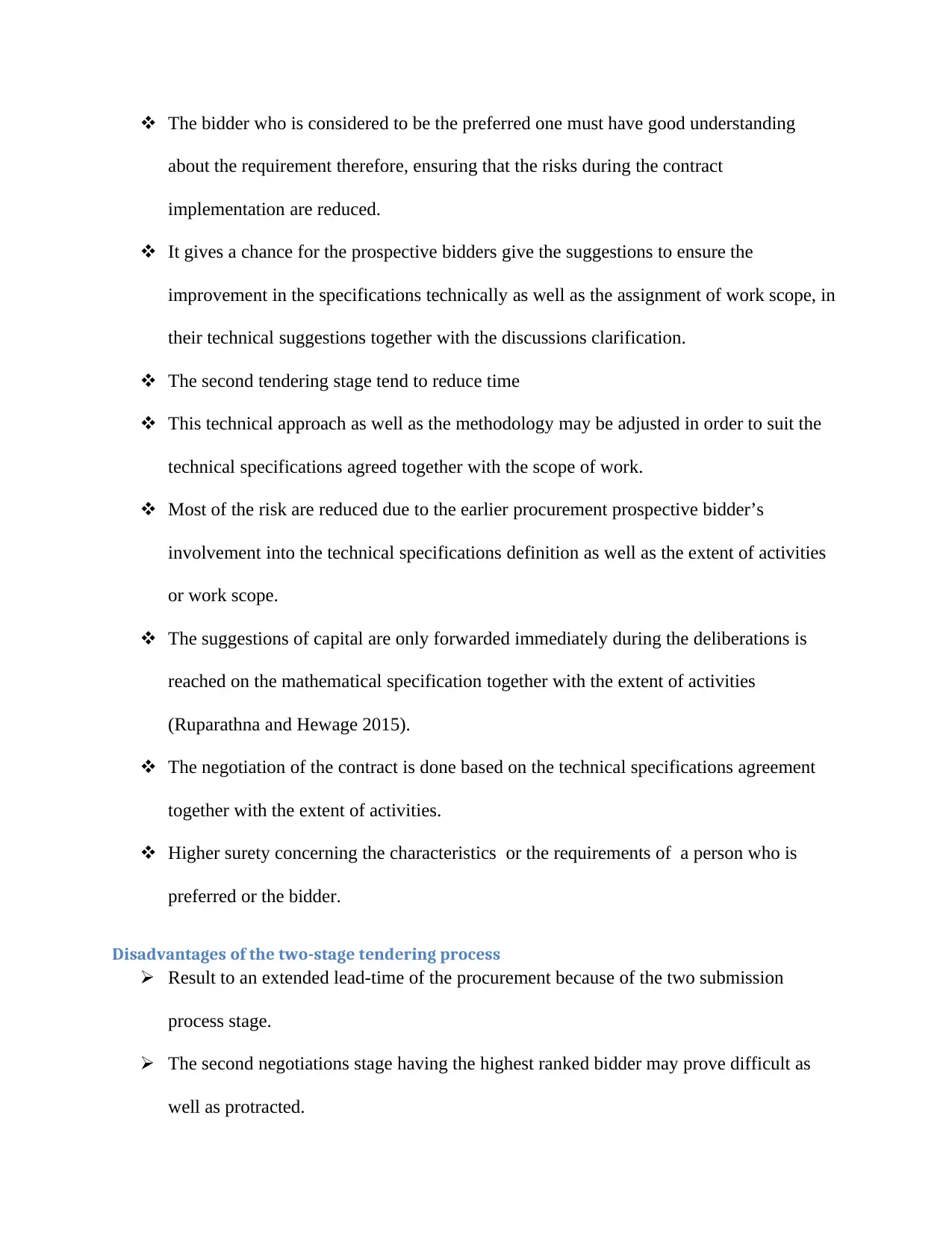
The bidder who is considered to be the preferred one must have good understanding
about the requirement therefore, ensuring that the risks during the contract
implementation are reduced.
It gives a chance for the prospective bidders give the suggestions to ensure the
improvement in the specifications technically as well as the assignment of work scope, in
their technical suggestions together with the discussions clarification.
The second tendering stage tend to reduce time
This technical approach as well as the methodology may be adjusted in order to suit the
technical specifications agreed together with the scope of work.
Most of the risk are reduced due to the earlier procurement prospective bidder’s
involvement into the technical specifications definition as well as the extent of activities
or work scope.
The suggestions of capital are only forwarded immediately during the deliberations is
reached on the mathematical specification together with the extent of activities
(Ruparathna and Hewage 2015).
The negotiation of the contract is done based on the technical specifications agreement
together with the extent of activities.
Higher surety concerning the characteristics or the requirements of a person who is
preferred or the bidder.
Disadvantages of the two-stage tendering process
Result to an extended lead-time of the procurement because of the two submission
process stage.
The second negotiations stage having the highest ranked bidder may prove difficult as
well as protracted.
about the requirement therefore, ensuring that the risks during the contract
implementation are reduced.
It gives a chance for the prospective bidders give the suggestions to ensure the
improvement in the specifications technically as well as the assignment of work scope, in
their technical suggestions together with the discussions clarification.
The second tendering stage tend to reduce time
This technical approach as well as the methodology may be adjusted in order to suit the
technical specifications agreed together with the scope of work.
Most of the risk are reduced due to the earlier procurement prospective bidder’s
involvement into the technical specifications definition as well as the extent of activities
or work scope.
The suggestions of capital are only forwarded immediately during the deliberations is
reached on the mathematical specification together with the extent of activities
(Ruparathna and Hewage 2015).
The negotiation of the contract is done based on the technical specifications agreement
together with the extent of activities.
Higher surety concerning the characteristics or the requirements of a person who is
preferred or the bidder.
Disadvantages of the two-stage tendering process
Result to an extended lead-time of the procurement because of the two submission
process stage.
The second negotiations stage having the highest ranked bidder may prove difficult as
well as protracted.
⊘ This is a preview!⊘
Do you want full access?
Subscribe today to unlock all pages.

Trusted by 1+ million students worldwide
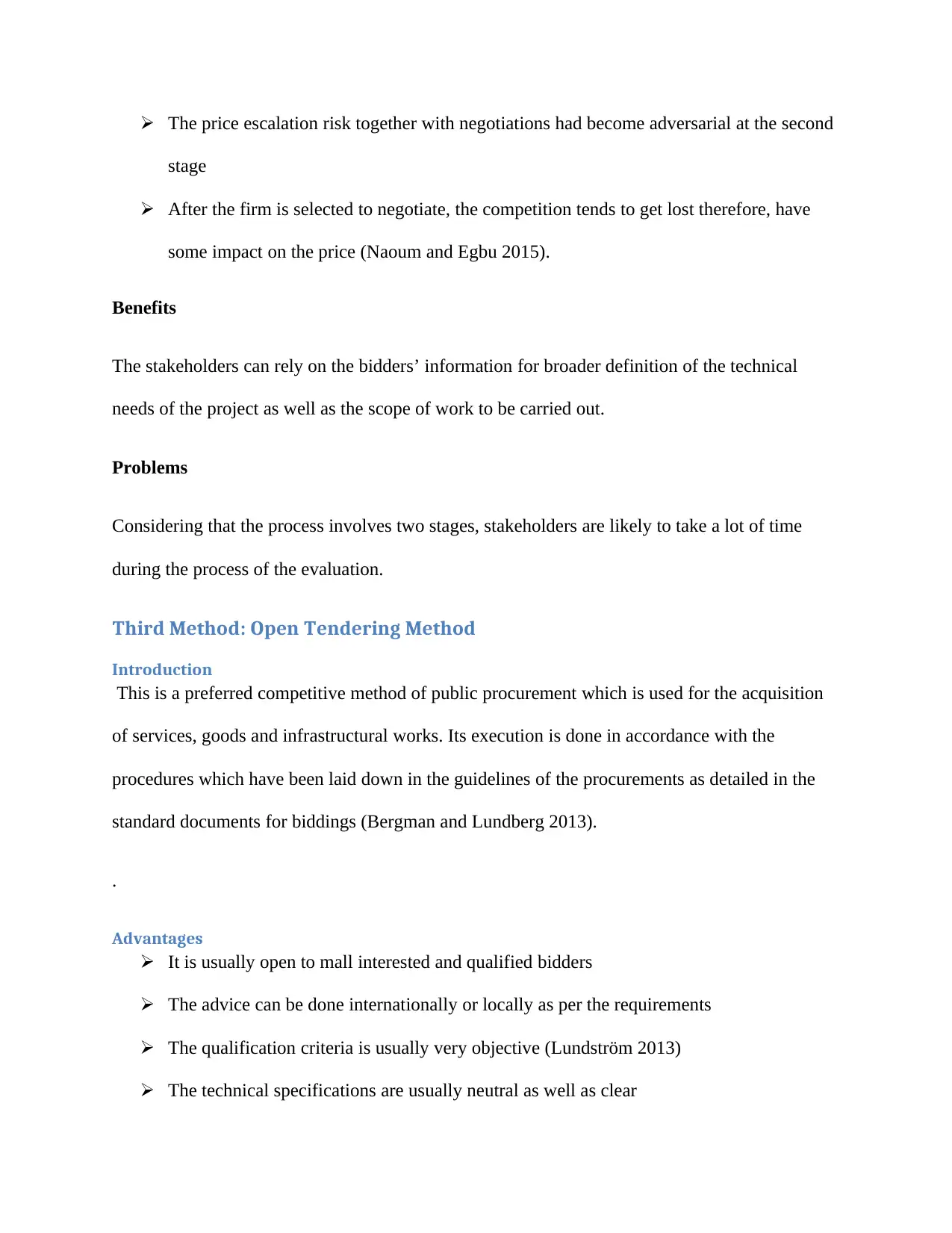
The price escalation risk together with negotiations had become adversarial at the second
stage
After the firm is selected to negotiate, the competition tends to get lost therefore, have
some impact on the price (Naoum and Egbu 2015).
Benefits
The stakeholders can rely on the bidders’ information for broader definition of the technical
needs of the project as well as the scope of work to be carried out.
Problems
Considering that the process involves two stages, stakeholders are likely to take a lot of time
during the process of the evaluation.
Third Method: Open Tendering Method
Introduction
This is a preferred competitive method of public procurement which is used for the acquisition
of services, goods and infrastructural works. Its execution is done in accordance with the
procedures which have been laid down in the guidelines of the procurements as detailed in the
standard documents for biddings (Bergman and Lundberg 2013).
.
Advantages
It is usually open to mall interested and qualified bidders
The advice can be done internationally or locally as per the requirements
The qualification criteria is usually very objective (Lundström 2013)
The technical specifications are usually neutral as well as clear
stage
After the firm is selected to negotiate, the competition tends to get lost therefore, have
some impact on the price (Naoum and Egbu 2015).
Benefits
The stakeholders can rely on the bidders’ information for broader definition of the technical
needs of the project as well as the scope of work to be carried out.
Problems
Considering that the process involves two stages, stakeholders are likely to take a lot of time
during the process of the evaluation.
Third Method: Open Tendering Method
Introduction
This is a preferred competitive method of public procurement which is used for the acquisition
of services, goods and infrastructural works. Its execution is done in accordance with the
procedures which have been laid down in the guidelines of the procurements as detailed in the
standard documents for biddings (Bergman and Lundberg 2013).
.
Advantages
It is usually open to mall interested and qualified bidders
The advice can be done internationally or locally as per the requirements
The qualification criteria is usually very objective (Lundström 2013)
The technical specifications are usually neutral as well as clear
Paraphrase This Document
Need a fresh take? Get an instant paraphrase of this document with our AI Paraphraser
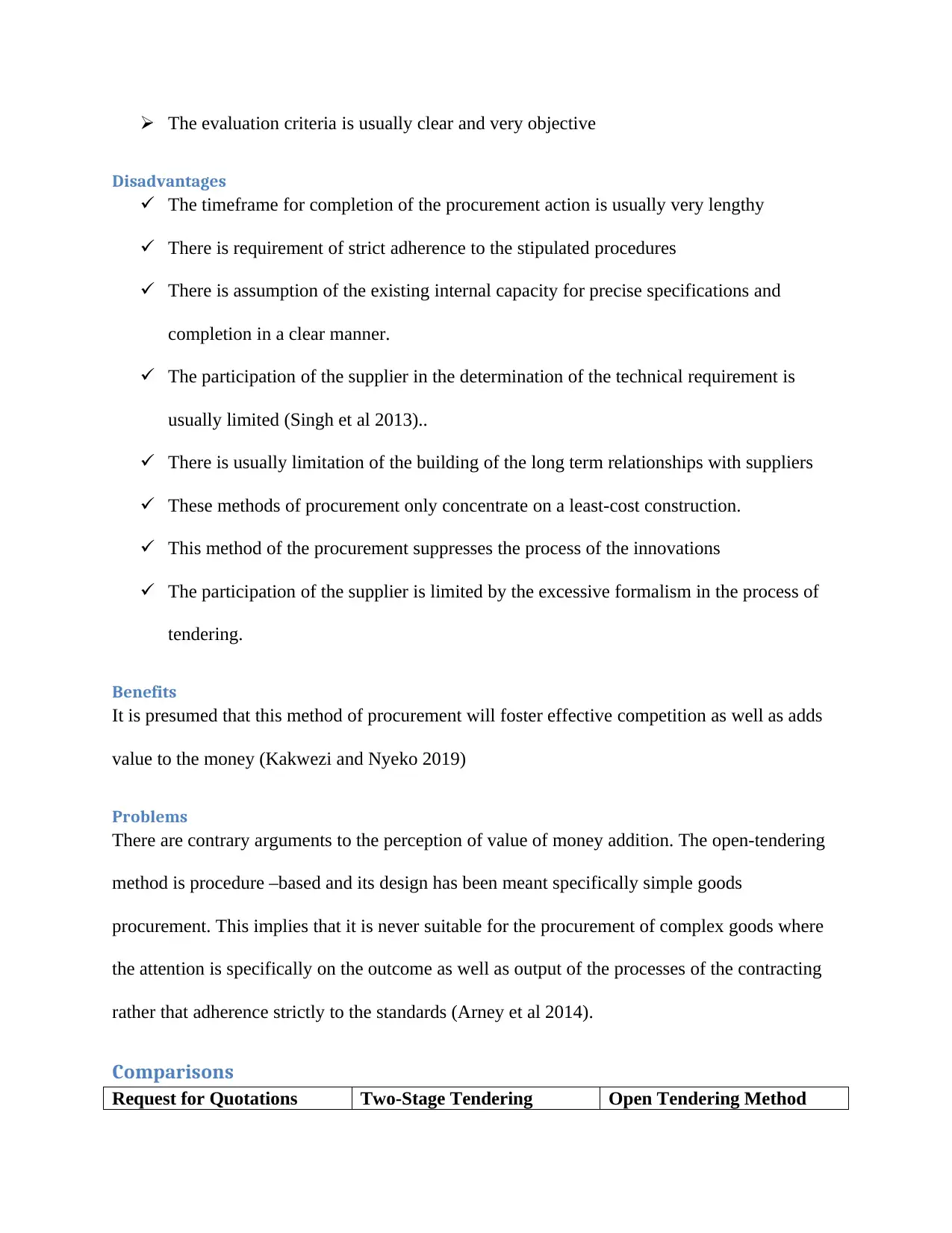
The evaluation criteria is usually clear and very objective
Disadvantages
The timeframe for completion of the procurement action is usually very lengthy
There is requirement of strict adherence to the stipulated procedures
There is assumption of the existing internal capacity for precise specifications and
completion in a clear manner.
The participation of the supplier in the determination of the technical requirement is
usually limited (Singh et al 2013)..
There is usually limitation of the building of the long term relationships with suppliers
These methods of procurement only concentrate on a least-cost construction.
This method of the procurement suppresses the process of the innovations
The participation of the supplier is limited by the excessive formalism in the process of
tendering.
Benefits
It is presumed that this method of procurement will foster effective competition as well as adds
value to the money (Kakwezi and Nyeko 2019)
Problems
There are contrary arguments to the perception of value of money addition. The open-tendering
method is procedure –based and its design has been meant specifically simple goods
procurement. This implies that it is never suitable for the procurement of complex goods where
the attention is specifically on the outcome as well as output of the processes of the contracting
rather that adherence strictly to the standards (Arney et al 2014).
Comparisons
Request for Quotations Two-Stage Tendering Open Tendering Method
Disadvantages
The timeframe for completion of the procurement action is usually very lengthy
There is requirement of strict adherence to the stipulated procedures
There is assumption of the existing internal capacity for precise specifications and
completion in a clear manner.
The participation of the supplier in the determination of the technical requirement is
usually limited (Singh et al 2013)..
There is usually limitation of the building of the long term relationships with suppliers
These methods of procurement only concentrate on a least-cost construction.
This method of the procurement suppresses the process of the innovations
The participation of the supplier is limited by the excessive formalism in the process of
tendering.
Benefits
It is presumed that this method of procurement will foster effective competition as well as adds
value to the money (Kakwezi and Nyeko 2019)
Problems
There are contrary arguments to the perception of value of money addition. The open-tendering
method is procedure –based and its design has been meant specifically simple goods
procurement. This implies that it is never suitable for the procurement of complex goods where
the attention is specifically on the outcome as well as output of the processes of the contracting
rather that adherence strictly to the standards (Arney et al 2014).
Comparisons
Request for Quotations Two-Stage Tendering Open Tendering Method
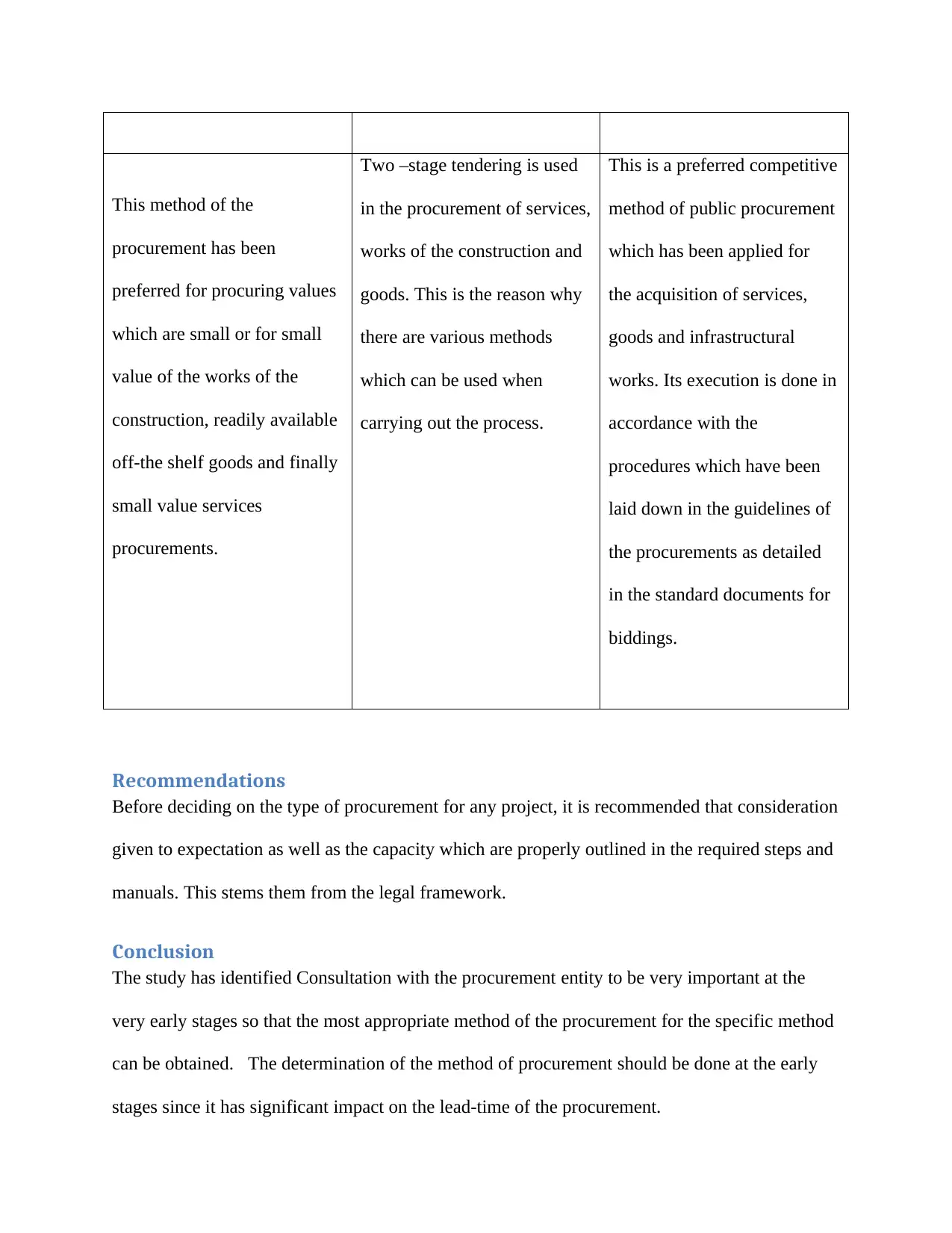
This method of the
procurement has been
preferred for procuring values
which are small or for small
value of the works of the
construction, readily available
off-the shelf goods and finally
small value services
procurements.
Two –stage tendering is used
in the procurement of services,
works of the construction and
goods. This is the reason why
there are various methods
which can be used when
carrying out the process.
This is a preferred competitive
method of public procurement
which has been applied for
the acquisition of services,
goods and infrastructural
works. Its execution is done in
accordance with the
procedures which have been
laid down in the guidelines of
the procurements as detailed
in the standard documents for
biddings.
Recommendations
Before deciding on the type of procurement for any project, it is recommended that consideration
given to expectation as well as the capacity which are properly outlined in the required steps and
manuals. This stems them from the legal framework.
Conclusion
The study has identified Consultation with the procurement entity to be very important at the
very early stages so that the most appropriate method of the procurement for the specific method
can be obtained. The determination of the method of procurement should be done at the early
stages since it has significant impact on the lead-time of the procurement.
procurement has been
preferred for procuring values
which are small or for small
value of the works of the
construction, readily available
off-the shelf goods and finally
small value services
procurements.
Two –stage tendering is used
in the procurement of services,
works of the construction and
goods. This is the reason why
there are various methods
which can be used when
carrying out the process.
This is a preferred competitive
method of public procurement
which has been applied for
the acquisition of services,
goods and infrastructural
works. Its execution is done in
accordance with the
procedures which have been
laid down in the guidelines of
the procurements as detailed
in the standard documents for
biddings.
Recommendations
Before deciding on the type of procurement for any project, it is recommended that consideration
given to expectation as well as the capacity which are properly outlined in the required steps and
manuals. This stems them from the legal framework.
Conclusion
The study has identified Consultation with the procurement entity to be very important at the
very early stages so that the most appropriate method of the procurement for the specific method
can be obtained. The determination of the method of procurement should be done at the early
stages since it has significant impact on the lead-time of the procurement.
⊘ This is a preview!⊘
Do you want full access?
Subscribe today to unlock all pages.

Trusted by 1+ million students worldwide

Disclaimer
The information given in regard to the methods of procurement with their merits and demerits
should be treated as impartial approach which has not been influenced by any interested party.
The information given in regard to the methods of procurement with their merits and demerits
should be treated as impartial approach which has not been influenced by any interested party.
Paraphrase This Document
Need a fresh take? Get an instant paraphrase of this document with our AI Paraphraser
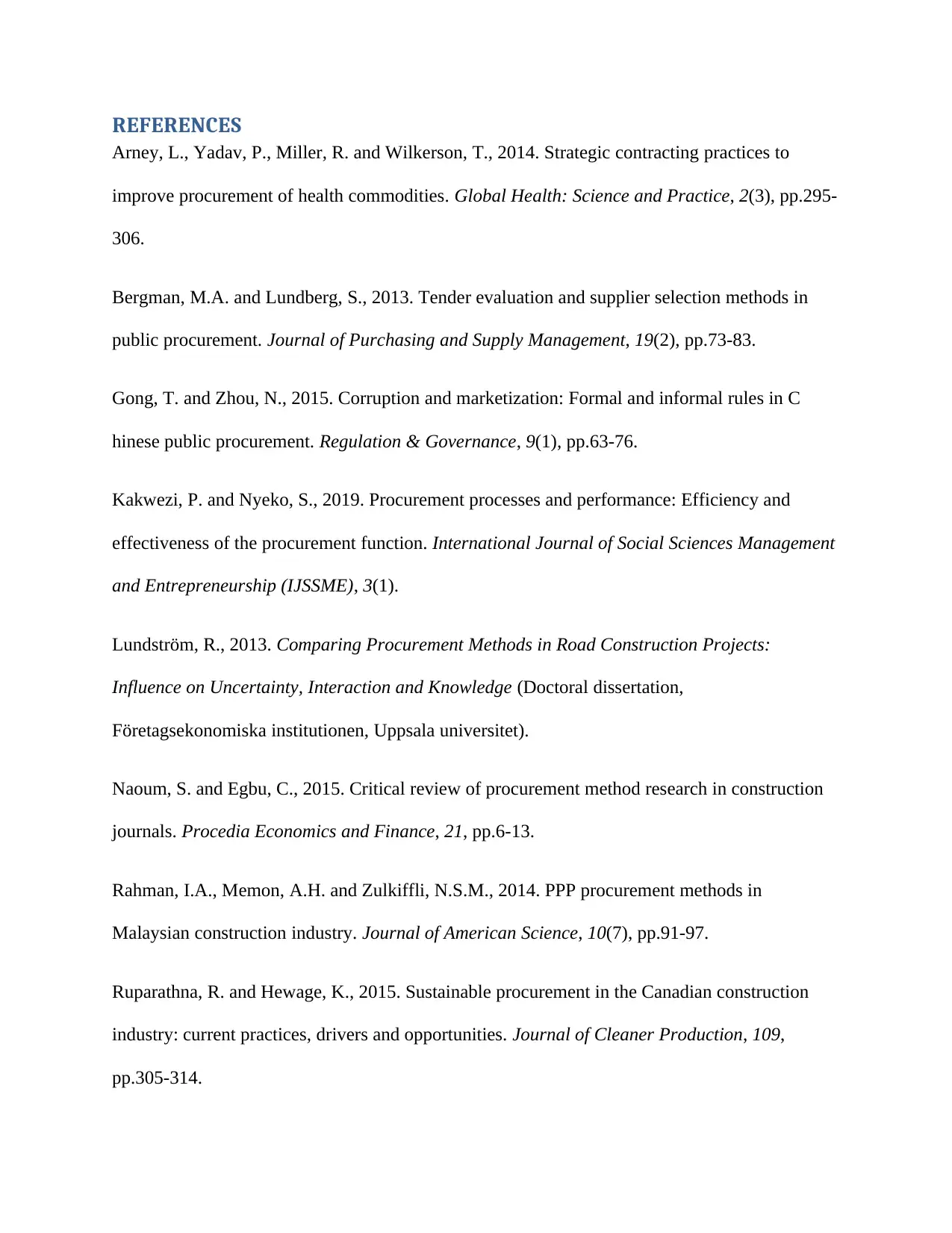
REFERENCES
Arney, L., Yadav, P., Miller, R. and Wilkerson, T., 2014. Strategic contracting practices to
improve procurement of health commodities. Global Health: Science and Practice, 2(3), pp.295-
306.
Bergman, M.A. and Lundberg, S., 2013. Tender evaluation and supplier selection methods in
public procurement. Journal of Purchasing and Supply Management, 19(2), pp.73-83.
Gong, T. and Zhou, N., 2015. Corruption and marketization: Formal and informal rules in C
hinese public procurement. Regulation & Governance, 9(1), pp.63-76.
Kakwezi, P. and Nyeko, S., 2019. Procurement processes and performance: Efficiency and
effectiveness of the procurement function. International Journal of Social Sciences Management
and Entrepreneurship (IJSSME), 3(1).
Lundström, R., 2013. Comparing Procurement Methods in Road Construction Projects:
Influence on Uncertainty, Interaction and Knowledge (Doctoral dissertation,
Företagsekonomiska institutionen, Uppsala universitet).
Naoum, S. and Egbu, C., 2015. Critical review of procurement method research in construction
journals. Procedia Economics and Finance, 21, pp.6-13.
Rahman, I.A., Memon, A.H. and Zulkiffli, N.S.M., 2014. PPP procurement methods in
Malaysian construction industry. Journal of American Science, 10(7), pp.91-97.
Ruparathna, R. and Hewage, K., 2015. Sustainable procurement in the Canadian construction
industry: current practices, drivers and opportunities. Journal of Cleaner Production, 109,
pp.305-314.
Arney, L., Yadav, P., Miller, R. and Wilkerson, T., 2014. Strategic contracting practices to
improve procurement of health commodities. Global Health: Science and Practice, 2(3), pp.295-
306.
Bergman, M.A. and Lundberg, S., 2013. Tender evaluation and supplier selection methods in
public procurement. Journal of Purchasing and Supply Management, 19(2), pp.73-83.
Gong, T. and Zhou, N., 2015. Corruption and marketization: Formal and informal rules in C
hinese public procurement. Regulation & Governance, 9(1), pp.63-76.
Kakwezi, P. and Nyeko, S., 2019. Procurement processes and performance: Efficiency and
effectiveness of the procurement function. International Journal of Social Sciences Management
and Entrepreneurship (IJSSME), 3(1).
Lundström, R., 2013. Comparing Procurement Methods in Road Construction Projects:
Influence on Uncertainty, Interaction and Knowledge (Doctoral dissertation,
Företagsekonomiska institutionen, Uppsala universitet).
Naoum, S. and Egbu, C., 2015. Critical review of procurement method research in construction
journals. Procedia Economics and Finance, 21, pp.6-13.
Rahman, I.A., Memon, A.H. and Zulkiffli, N.S.M., 2014. PPP procurement methods in
Malaysian construction industry. Journal of American Science, 10(7), pp.91-97.
Ruparathna, R. and Hewage, K., 2015. Sustainable procurement in the Canadian construction
industry: current practices, drivers and opportunities. Journal of Cleaner Production, 109,
pp.305-314.

Singh, P.V., Tatambhotla, A., Kalvakuntla, R. and Chokshi, M., 2013. Understanding public
drug procurement in India: a comparative qualitative study of five Indian states. BMJ open, 3(2),
p.e001987.
drug procurement in India: a comparative qualitative study of five Indian states. BMJ open, 3(2),
p.e001987.
⊘ This is a preview!⊘
Do you want full access?
Subscribe today to unlock all pages.

Trusted by 1+ million students worldwide
1 out of 12
Related Documents
Your All-in-One AI-Powered Toolkit for Academic Success.
+13062052269
info@desklib.com
Available 24*7 on WhatsApp / Email
![[object Object]](/_next/static/media/star-bottom.7253800d.svg)
Unlock your academic potential
Copyright © 2020–2025 A2Z Services. All Rights Reserved. Developed and managed by ZUCOL.





